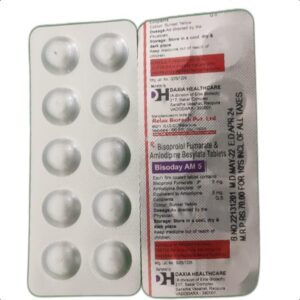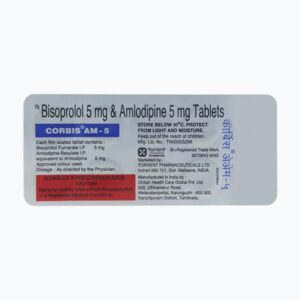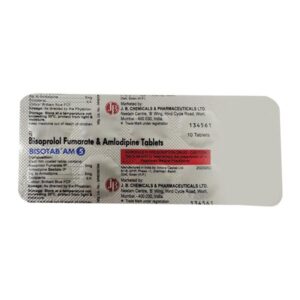AMLODIPINE + BISOPROLOL
Amlodipine: Amlodipine is a prescription medication used for the treatment of high blood pressure (hypertension) and certain types of chest pain called angina. It belongs to a class of medications known as calcium channel blockers.
The primary mechanism of action of amlodipine is to relax and widen the blood vessels. By blocking the entry of calcium ions into muscle cells of the blood vessels, it prevents them from contracting, which results in the dilation of the blood vessels. This dilation lowers blood pressure and improves blood flow, reducing the workload on the heart and relieving chest pain.
Amlodipine is typically taken by mouth in tablet form, with or without food. The dosage may vary depending on the individual’s condition, but the usual starting dose for hypertension is 5 mg once daily, and for angina, it is 5-10 mg once daily. In some cases, the dosage may be adjusted upwards or downwards based on the person’s response to the medication and the guidance of their healthcare provider.
Common side effects of amlodipine may include dizziness, headache, flushing, swollen ankles or feet, and stomach pain. These side effects are usually mild and temporary. However, some individuals may experience more severe side effects such as a rapid or pounding heartbeat, severe dizziness, or fainting. It is important to seek immediate medical attention if any severe side effects occur.
Amlodipine may interact with other medications, including certain antibiotics, antifungals, and medications used to treat HIV or hepatitis C. It is crucial to inform the healthcare provider of all the medications and supplements being used to avoid potential drug interactions.
It is important to note that amlodipine should not be stopped abruptly without consulting a healthcare professional, as sudden discontinuation may lead to rebound high blood pressure or worsening chest pain.
Bisoprolol: Bisoprolol is a medication primarily used in the treatment of hypertension (high blood pressure) and heart failure. It belongs to the class of medications known as beta-blockers.
The mechanism of action of bisoprolol involves blocking the effects of adrenaline on the body’s beta receptors. By doing so, it reduces the heart rate and blood pressure, thereby making it easier for the heart to pump blood and decreasing the workload on the heart.
The dose of bisoprolol may vary depending on the individual’s condition and response to the medication. Typically, the starting dose for hypertension is 5 mg once daily, which can be increased to 10 mg once daily if necessary. For heart failure, the starting dose is usually 1.25 mg once daily, which is gradually increased to a target dose of 10 mg once daily over several weeks.
Like any medication, bisoprolol is associated with potential side effects. Common side effects may include fatigue, dizziness, headache, nausea, and cold hands or feet. More serious but rare side effects can include slow heart rate, low blood pressure, difficulty breathing, depression, or worsening heart failure symptoms. It is essential to report any concerning side effects to a healthcare provider.
Bisoprolol should not be stopped abruptly as it can cause a rebound effect with a sudden increase in heart rate and blood pressure. If discontinuing bisoprolol, it is important to do so under the guidance of a healthcare professional to gradually reduce the dose.
As with any medication, it is important to consult with a healthcare provider for proper evaluation, guidance, and monitoring when considering or using bisoprolol.



